
Primula is a genus of herbaceous flowering plants in the family Primulaceae. They include the primrose, a familiar wildflower of banks and verges. Other common species are P. auricula (auricula), P. veris (cowslip), and P. elatior (oxlip). These species and many others are valued for their ornamental flowers. They have been extensively cultivated and hybridised. Primula are native to the temperate Northern Hemisphere, south into tropical mountains in Ethiopia, Indonesia, and New Guinea, and in temperate southern South America. Almost half of the known species are from the Himalayas.

Pollination is the transfer of pollen from an anther of a plant to the stigma of a plant, later enabling fertilisation and the production of seeds, most often by an animal or by wind. Pollinating agents can be animals such as insects, for example beetles; birds, butterflies, and bats; water; wind; and even plants themselves. Pollinating animals travel from plant to plant carrying pollen on their bodies in a vital interaction that allows the transfer of genetic material critical to the reproductive system of most flowering plants. When self-pollination occurs within a closed flower. Pollination often occurs within a species. When pollination occurs between species, it can produce hybrid offspring in nature and in plant breeding work.

Lupinus polyphyllus, the large-leaved lupine, big-leaved lupine, many-leaved lupine, blue-pod lupine, or, primarily in cultivation, garden lupin, is a species of lupine (lupin) native to western North America from southern Alaska and British Columbia and western Wyoming, and south to Utah and California. It commonly grows along streams and creeks, preferring moist habitats.

Oenothera is a genus of about 145 species of herbaceous flowering plants native to the Americas. It is the type genus of the family Onagraceae. Common names include evening primrose, suncups, and sundrops. They are not closely related to the true primroses.
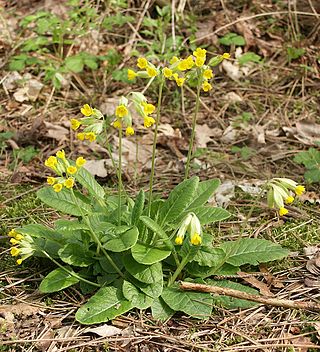
Primula veris, the cowslip, common cowslip, or cowslip primrose, is a herbaceous perennial flowering plant in the primrose family Primulaceae. The species is native throughout most of temperate Europe and western Asia, and although absent from more northerly areas including much of northwest Scotland, it reappears in northernmost Sutherland and Orkney and in Scandinavia. This species frequently hybridizes with other Primulas such as the common primrose Primula vulgaris to form false oxlip which is often confused with true oxlip, a much rarer plant.

Magnolia sieboldii, or Siebold's magnolia, also known as Korean mountain magnolia and Oyama magnolia, is a species of Magnolia native to east Asia in China, Japan, and Korea. It is named after the German doctor Philipp Franz von Siebold (1796–1866).

Primula vulgaris, the common primrose, is a species of flowering plant in the family Primulaceae, native to western and southern Europe, northwest Africa, and parts of southwest Asia. The common name is primrose, or occasionally common primrose or English primrose to distinguish it from other Primula species also called primroses. None of these are closely related to the evening primroses.

Heterostyly is a unique form of polymorphism and herkogamy in flowers. In a heterostylous species, two or three morphological types of flowers, termed "morphs", exist in the population. On each individual plant, all flowers share the same morph. The flower morphs differ in the lengths of the pistil and stamens, and these traits are not continuous. The morph phenotype is genetically linked to genes responsible for a unique system of self-incompatibility, termed heteromorphic self-incompatibility, that is, the pollen from a flower on one morph cannot fertilize another flower of the same morph.
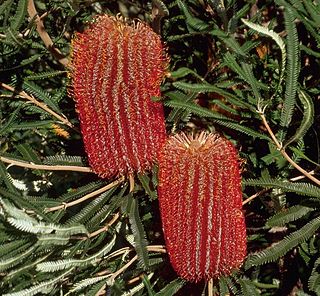
Banksia brownii, commonly known as feather-leaved banksia or Brown's banksia, is a species of shrub that grows in southwest Western Australia. A plant with fine feathery leaves and large red-brown flower spikes, it usually grows as an upright bush around two metres (6.6 ft) high, but can also occur as a small tree or a low spreading shrub. First collected in 1829 and published the following year, it is placed in Banksiasubgenus Banksia, section Oncostylis, series Spicigerae. There are two genetically distinct forms.

Primula scotica, commonly known as Scottish primrose, is a species of flowering plant in the family, Primulaceae, the primroses and their relatives. It was first described by James Smith, and is endemic to the north coast of Scotland.

Melocactus glaucescens is a species of plant in the family Cactaceae. It is endemic to Brazil. Its natural habitats are rocky areas and hot deserts. It is threatened by habitat loss.
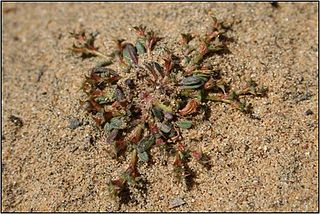
Chorizanthe orcuttiana is a rare small annual plant in the buckwheat family, Polygonaceae. It is known commonly as Orcutt's spineflower or the San Diego spineflower, and it is endemic to San Diego County, California. The plant is diminutive, and a hand-lens is necessary for proper identification. The plant is very sensitive to temperature and precipitation, and under drought or hot conditions the seeds will not germinate or survive. The plant is visible anywhere from February through July during good rain year, but most years the plant is only visible from April to June. Each minute flower yields one seed.

Abronia ammophila, the Yellowstone sand verbena, or Wyoming sand verbena, is a plant unique to Yellowstone National Park lakeshores and is endemic to the park. Part of the "Four o'clock" family (Nyctaginaceae), the abronia ammophila is best suited in sandy soils and lake shores.

Hydrangea hirta, also known as the nettle-leaved hydrangea, is a species of flowering plant in the family Hydrangeaceae that is native to East Asia. Due to the beauty and sturdiness of the species' flowers it can be found outside of its range being used for horticultural and landscaping purposes, and is found in gardens in countries including the United Kingdom and the United States.

Clematis socialis is a rare species of flowering plant in the buttercup family known by the common name Alabama leather flower. It is native to the US states of Alabama and Georgia, where it is known from only five populations. The species is seriously threatened by habitat destruction. It is a federally listed endangered species.
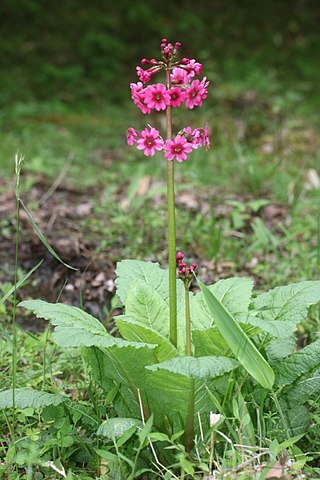
Primula japonica, the Japanese primrose, Japanese cowslip, Queen of primroses, or valley red, is a species of flowering plant in the family Primulaceae, native to Japan. The common name Japanese primrose also applies to the related species Primula sieboldii.

Primula pulverulenta, the mealy primrose or mealy cowslip, is a species of flowering plant in the family Primulaceae, native to damp habitats in China. It is a herbaceous perennial growing to 100 cm (39 in) tall by 60 cm (24 in) broad, with strong stems of deep pink flowers arising from basal rosettes of leaves in early summer. The flowers are grouped at intervals along the stem in a tiered formation, hence the common name "candelabra primula" which is often applied to this and other species with a similar arrangement.

Distyly is a type of heterostyly in which a plant demonstrates reciprocal herkogamy. This breeding system is characterized by two separate flower morphs, where individual plants produce flowers that either have long styles and short stamens, or that have short styles and long stamens. However, distyly can refer to any plant that shows some degree of self-incompatibility and has two morphs if at least one of the following characteristics is true; there is a difference in style length, filament length, pollen size or shape, or the surface of the stigma. Specifically these plants exhibit intra-morph self-incompatibility, flowers of the same style morph are incompatible. Distylous species that do not exhibit true self-incompatibility generally show a bias towards inter-morph crosses - meaning they exhibit higher success rates when reproducing with an individual of the opposite morph.
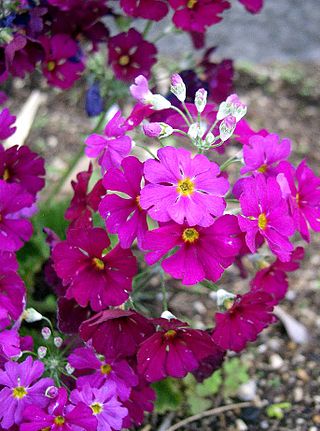
Primula malacoides, called the fairy primrose or baby primrose, is a perennial species of Primula native to the Himalayas, Assam in India, Myanmar, and south-central and south east China. It has gained the Royal Horticultural Society's Award of Garden Merit.

Hibiscus hamabo, the hardy yellow hibiscus, is a species of shrub in the genus Hibiscus that is native to the coastlines of China, Japan, and Korea. It is characterized by yellow flower coloring as well as orbicular shaped leaves. In its native environment it is a perennial.



















